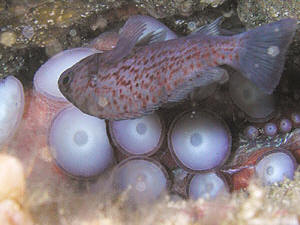
A giant octopus' (E. dolfleini) suckers.
Picture: Sami Laine from kelpdiver.com.
 A giant octopus' (E. dolfleini) suckers. Picture: Sami Laine from kelpdiver.com. |
The name "octopus" comes from Greek. It means eight-foot, and that also makes an octopus special among other cephalopods. Where a squid or a cuttlefish has got ten arms, an octopus has got eight. In that regard, octopuses have something in common with their nearest relatives, the argonauts, which also have got eight arms.
The number of their arms is not the only thing, which separates octopuses from other cephalopods. It is also the absence of a shell. All cephalopods, leaving aside the ancient Nautilus, which still has got an external shell, have got the tendency to reduce their shell, so squids only have left an internal sword-shaped structure called the gladius and cuttlefish have their internal cuttlebone, also a remainder of a shell. Octopuses have got neither, they lack any trace of a shell, internal or external.
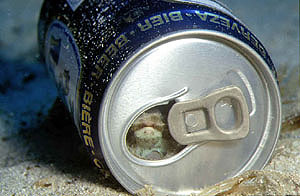 A young octopus hidden in a beer can. Picture: Robert Patzner, Salzburg University. |
Without an inner shell, octopuses are highly flexible and so they can hide in the most interesting places, like the young octopus in the picture on the right hidden in a beer can. Contrary to most other cephalopods, octopuses mainly live in the benthic, on the ocean floor. Like the Scylla from Homer's odyssey, octopuses like to hide in a cave and reach into the surrounding water with their arms to catch crabs, snails and mussels, but also other octopuses.
Octopuses, like other cephalopods, breathe with gills. That means they cannot survive on dry land for a long time. But they can stay there for a short period of time, which they use during low tide to hunt in tide pools.
Some octopus species also swim through open water, for example, to get from one reef to the other. To do so, they move by pressing water from their pallial (mantle) cavity through the funnel, also called the siphon. Their eight arms are not used for swimming, which is why they are dragged behind.
 An octopus breathing. The pallial (mantle) cavity and siphon are well visible. Photo: Jim Cosgrove. |
![]() Swimming blue-ringed octopus on flickr.com.
Swimming blue-ringed octopus on flickr.com.
Octopuses catch their prey in a similar way to other cephalopods, by means of their tentacles. After they managed to do so, their prey is pulled towards the octopus' mouth opening, where the strong horn beak can bite a hole in the prey's armour – most creatures octopuses prey on either have got a carapace (like crabs) or a shell (like snails, mussels and other molluscs). Then the octopus will liquefy its prey's interior organs and suck the resulting protein liquid.
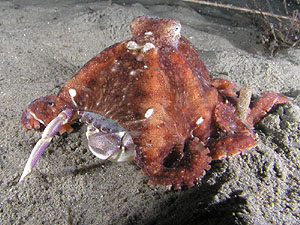 Giant octopus (Enteroctopus dolfleini) feeding on a crab. Picture: Sami Laine from kelpdiver.com. |
As a consequence, an octopus' hiding place will often be recognisable by the crab shells littering around it.
When they have to defend themselves, some octopus species can deal painful bites: The blue-ringed octopuses from Australia are so poisonous, that each year accidents happen because careless beach walkers get bitten after they found such a small octopus in a tide pool and tried to pick it up.
Octopuses also have got another, more defensive, weapon – ink. In a bladder-like organ branching off the intestine, they produce a black liquid, which is released into the surrounding water, forming a cloud. While the attacker deals with the fake octopus, the real thing gets time to escape after changing colour, and camouflaging to fit the environment.
Octopuses are very short-lived animals with a life span of one or two years. Their life usually ends after mating and the hatching of the young. Whereas the male usually dies soon after mating, the female lives a bit longer to have time to watch over the eggs, until the young hatch. Sometimes the female octopuses live noticeably longer than the males.
During copulation, the male transfers a spermatophore to the female, using one of its tentacles, specially formed to fit the task. Such a special tentacle is also called a hectocotylus. The female octopus will store the sperm in a special bladder organ, the Receptaculum seminis (sperm receptacle, see also: Genital apparatus of the Roman snail). Later, usually separated from the process of mating by a space of time, the female will use those sperms to fertilise the egg cells, as soon as the environmental conditions are favourable.
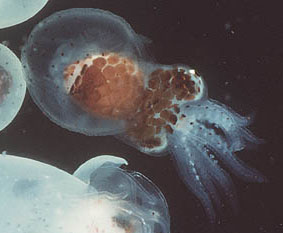 Freshly hatched octopus larva. Photo: Jim Cosgrove. |
As long, as the young octopuses grow in their eggs, the mother will watch over the cave they are usually laid in, guarding them, cleaning them, supplying them with oxygen and occasionally defending them. In all this time, a female octopus will never leave its offspring, which is why she only eats very little. When the young octopuses have hatched, the mother often will die from weakness and exhaustion, or she is fed upon, since now she herself cannot defend against her enemies anymore. After hatching, the young octopuses thus are left to themselves, swimming in the open sea (the pelagic), contrary to the adults living in the benthic. The losses to be expected are compensated by the high number of octopus offspring: Each batch of eggs may contain as many as 150,000 young octopuses.
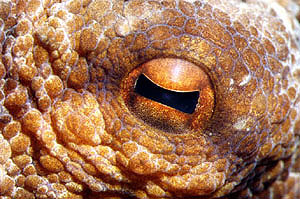 The eye of an octopus ( Picture: Robert Patzner, Salzburg University. |
Octopuses' nervous systems are very effective in different regards; their brain, octopuses being invertebrate molluscs, more than that of a fish, a vertebrate. Especially highly developed centres are the optical lobes and the centres responsible for guiding the colour cells in the skin. Octopus eyes are the most advanced light sense organs among all invertebrates. An octopus has got lens eyes, generally equal to vertebrates' eyes, at its disposal. Mollusc eyes, however, have evolved in a diffenrent way than vertebrate eyes. The retina develops as a part of the eyeball and thus is innerved only later. So the light sensitive cells in the retina point into the inner space of the eyeball, towards the incident light. In that way, a mollusc's everse eye is noticeably different from a vertebrate's inverse eye, as in the latter the eye nerve grows into the eye only later, so the light sense cell point outwards, away from the light falling in.
Similarly remarkable is the innervation of an octopus' tentacles. Male argonauts, for example, which also belong to the octopodids, can separate their hectocotylus, which then will find the way into the female's mantle cavity on its own (a fire-and-forget hectocotylus, so to speak).
Also, tentacles involuntarily separated from the body (Argonauts are the only octopodids, which can voluntarily separate an arm) will continue to move on their own.
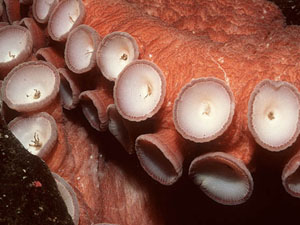 A giant octopus' tentacles. Photo: Jim Cosgrove. |
In general, octopuses do not have to guide all tentacle motions from the brain, but neural patterns stored in the tentacles allow at least for simple movements. A tentacle's suckers are also connected to nerves and they are provided with chemical sense cells, which give information on the matter touched.
In the skin, there are pigment cells (chromatophores) which can be guided separately. So apart from their highly flexible and changeable form, an octopus can also change its colour, an ability, in which octopuses have achieved mere mastership. The colour of their skin is not only used by octopuses as a means of camouflage but also of communication with others of their kind. The blue-ringed octopuses from Australia are called that way because they display different kinds of blue ring patterns on their skin. But they only do so as a warning. Otherwise a blue-ringed octopus' colour is a bleak yellowish brown. It should be kept in mind, though, that octopuses, other than their squid relatives, are loners, which will defend their territory, eating also their smaller relatives, even their own kind.
Apart from their extremely effective nervous system, octopuses also are very good at learning things. They can remember colours and forms, as well as to find their way out of a labyrinth. It has been proven that octopuses can open closed boxes and uncork bottles to reach food. Octopuses also learn by watching a process without having tried it before. In an experiment on the learning abilities of octopuses, it has been found that octopuses can connect colours with food given in the case of success and that they also could remember simple forms. Octopuses kept in neighbouring tanks acquired that knowledge by observing their neighbours' progress in the experiment.
|
|
Octopuses' learning abilities can be explained by their evolution in competition with other highly developed sea creatures. Octopuses also must be able to learn fast, as they have not the ability to pass on their knowledge because of their low life span of maximally four years. Also, because the mother dies after the young hatched, all abilities must be acquired freshly.
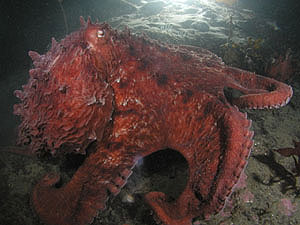 A giant octopus (Enteroctopus dofleini). Picture: Sami Laine from kelpdiver.com. |
Octopuses can be found in all seas on Earth. Their size may reach from a few centimetres to the Pacific giant octopus (Enteroctopus dofleini), which may measure four metres span width. Octopuses live in different habitats between the tidal zone and up to seven kilometres depth. In the Mediterranean, there is for example the Common octopus (Octopus vulgaris) with a tentacle length of up to one metre and the little larger White Spotted octopus (Octopus macropus). Smaller species are the lesser octopus (Eledone cirrhosa) and the Musk octopus (Eledone moschata) with up to forty centimetres tentacle length.
The largest known octopus is the Giant octopus (Enteroctopus dofleini) from the northern Pacific occurring on the American northwest coast. It may reach a tentacle length of more than two metres, there may even be specimens of more than three metres arm length, resulting in a seven metres span width.
In Australia and Southeast Asia, there is the genus of blue-ringed octopuses (Hapalochlaena). Those small octopuses (about ten centimetres tentacle length) are specially known for their characteristic warning colour, as well as for their highly poisonous venom. A blue ringed octopus' saliva contains tetrodotoxin, a neural poison that will paralyse all conscious muscles killing the victim in less than a few hours. Most interestingly, it is produced not by the octopus, but by bacteria living in the salivary glands.
In total, about 200 species of octopus are known to science, many of which, though, are not specified.